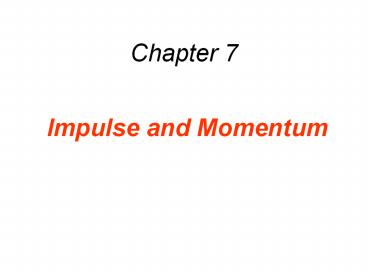Impulse and Momentum - PowerPoint PPT Presentation
1 / 20
Title:
Impulse and Momentum
Description:
Chapter 7 Impulse and Momentum 7.1 The Impulse-Momentum Theorem There are many situations when the force on an object is not constant. 7.1 The Impulse-Momentum ... – PowerPoint PPT presentation
Number of Views:159
Avg rating:3.0/5.0
Title: Impulse and Momentum
1
Chapter 7
- Impulse and Momentum
2
7.1 The Impulse-Momentum Theorem
There are many situations when the force on an
object is not constant.
3
7.1 The Impulse-Momentum Theorem
DEFINITION OF IMPULSE The impulse of a force is
the product of the average force and the time
interval during which the force acts
Impulse is a vector quantity and has the same
direction as the average force.
4
7.1 The Impulse-Momentum Theorem
5
7.1 The Impulse-Momentum Theorem
DEFINITION OF LINEAR MOMENTUM The linear
momentum of an object is the product of the
objects mass times its velocity
Linear momentum is a vector quantity and has the
same direction as the velocity.
6
7.1 The Impulse-Momentum Theorem
IMPULSE-MOMENTUM THEOREM When a net force acts
on an object, the impulse of this force is equal
to the change in the momentum of the object
impulse
final momentum
initial momentum
7
7.2 The Principle of Conservation of Linear
Momentum
Internal forces Forces that objects within the
system exert on each other.
External forces Forces exerted on objects by
agents external to the system.
8
7.2 The Principle of Conservation of Linear
Momentum
PRINCIPLE OF CONSERVATION OF LINEAR MOMENTUM The
total linear momentum of an isolated system is
constant (conserved). An isolated system is one
for which the sum of the average external forces
acting on the system is zero.
9
7.2 The Principle of Conservation of Linear
Momentum
PRINCIPLE OF CONSERVATION OF LINEAR MOMENTUM The
total linear momentum of an isolated system is
constant (conserved). An isolated system is one
for which the sum of the average external forces
acting on the system is zero.
In the top picture the net external force on
the system is zero.
In the bottom picture the net external force on
the system is not zero.
10
7.3 Collisions in One Dimension
The total linear momentum is conserved when two
objects collide, provided they constitute an
isolated system.
Elastic collision -- One in which the total
kinetic energy of the system after the
collision is equal to the total kinetic energy
before the collision. Inelastic collision --
One in which the total kinetic energy of the
system after the collision is not equal to the
total kinetic energy before the collision if
the objects stick together after colliding, the
collision is said to be completely inelastic.
11
7.3 Collisions in One Dimension
Example 8 A Ballistic Pendulum The mass of the
block of wood is 2.50-kg and the mass of the
bullet is 0.0100-kg. The block swings to a
maximum height of 0.650 m above the initial
position. Find the initial speed of the bullet.
12
7.3 Collisions in One Dimension
Apply conservation of momentum to the collision
13
7.3 Collisions in One Dimension
Applying conservation of energy to the swinging
motion
14
7.3 Collisions in One Dimension
15
7.4 Collisions in Two Dimensions
16
7.5 Center of Mass
The center of mass is a point that represents the
average location for the total mass of a system.
17
Problems to be solved
- 7.8, 7.34, 7.41, 7.44, 7.60, 7.64
- B7.1 A 1000kg car moving at 20m/s hits a 2000kg
parked car head on. How much mechanical energy
is dissipated if the collision is (a) elastic,
(b) completely inelastic? Ans. (a)None, because
mechanical energy is conserved during elastic
collisions. (b) 13.33104J
18
- B7.2 A bullet of mass 10-2kg and initial
horizontal velocity of 250m/s strikes and is
embedded in a 1kg wooden block. The wooden block
hangs on the end of a long string. (a) What is
the velocity of the block and bullet after
impact? (b) How high will the block and bullet
swing upward? Ans (a) 2.48m/s (b) 0.31m
19
- B7.3 Two cars approaching each other along
streets that meet at a right angle collide at the
intersection. After the crash, they stick
together. If one car has a mass of 1450kg and an
initial speed of 11.5m/s and the other has a mass
of 1750kg and an initial speed of 15.5m/s, what
will be their speed and direction immediately
after impact? Ans 9.95m/s 58.4º
20
- B7.4 A billiard ball moving at 10.0m/s along the
positive x-axis collides with a second billiard
ball at rest. The balls have identical masses.
After the collision, the incoming (or incident)
ball moves on with a speed of 7.7m/s at an angle
of 40 from the x-axis. What are the speed and
direction of motion of the struck ball? - Ans 6.43m/s -50.37º































